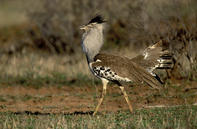
Name
Kori bustard (Ardeotis kori)Appearance
The kori bustard is Africa’s heaviest flying bird and can weigh up to 19 kg. It is a light brown to grey ground-dwelling bird with a long neck. The underparts are buff coloured with dark brown vermiculations (dense but irregular lines).
The tail has wide bands of greyish brown and white. The primaries, or flight feathers, are also similarly marked. The shoulder area has a chequered black and white pattern. The sides of the crown on the head extend into a black crest.
There is a white stripe over each eye. The chin, throat, and neck are a creamy white mixed with black bands. The long legs end in a foot with three forward facing toes.
Kori Bustard Diet
The kori bustard is an omnivore, eating both plant-like berries and reptiles like lizards and snakes. Chicks are fed insects. It has been found that they eat the gum from the Acacia tree.
Whether they are feeding on insects that may eat the gum themselves or are digesting the gum directly has not been determined. Kori bustards drink water using a sucking motion, unlike other birds that scoop up the water with their bills.
Kori Bustard Breeding
Kori bustards are considered to be a polygynous species. During courtship, the male will inflate its neck and trail its wings as it dances before the female.
Some male bustards even act further and ruffle all their feathers looking like a great white ball. They may also bow toward the female while inflating the bill. Males are likely to make a booming ‘woum-woum-woum-woum’ sound. Breeding males display this act either early in the day, or late afternoon. Males take no part in raising the young.
Females remain on the nest most of the time, leaving it for only short intervals to feed. Breeding usually only occurs once a year in South Africa lasting about 23-30 days. It is common for a female not to build a thick nest; she may even just lay the eggs on the ground.
Kori Bustard Behaviour
The kori bustard is a ground-dweller, hence the name bustard, meaning birds that walk. They have a majestic walk with measured strides. They prefer to walk away from danger and because of their weight fly only when necessary.
They take off with very heavy wing beats, but once air-borne they fly quickly and strongly. Kori bustards may even become categorized with the few large flightless birds like ostriches and emus. They may be returning to an ancient ancestral form since they, and the other cranes, are descendants of large flightless predators.
Kori bustards are seen alone, in pairs or groups in woodland, grassy plains and Kalahari scrub. They tend to remain in the same area as long as the food source is good. When in a group, the birds walk in a loose line across the grasslands searching for food.
They have a long life span and breed slowly. In courtship, the male inflates its throat to spread the white frontal neck feathers outwards, the head with raised crest is drawn back, the wings are drooped and the tail is deflected upwards and forwards to the neck.
 SouthAfrica.co.za provides informative, educational content on many South African bird species that orthologists and bird-watchers would enj...
SouthAfrica.co.za provides informative, educational content on many South African bird species that orthologists and bird-watchers would enj...